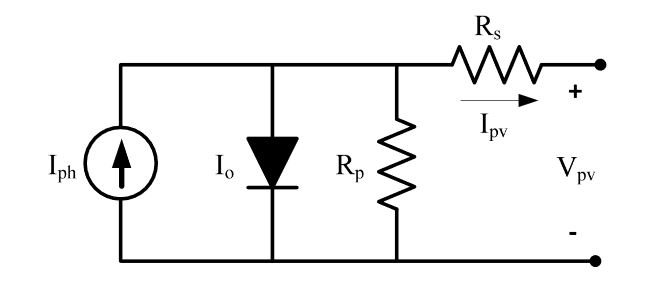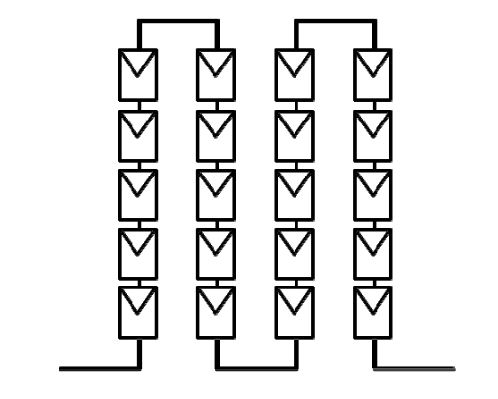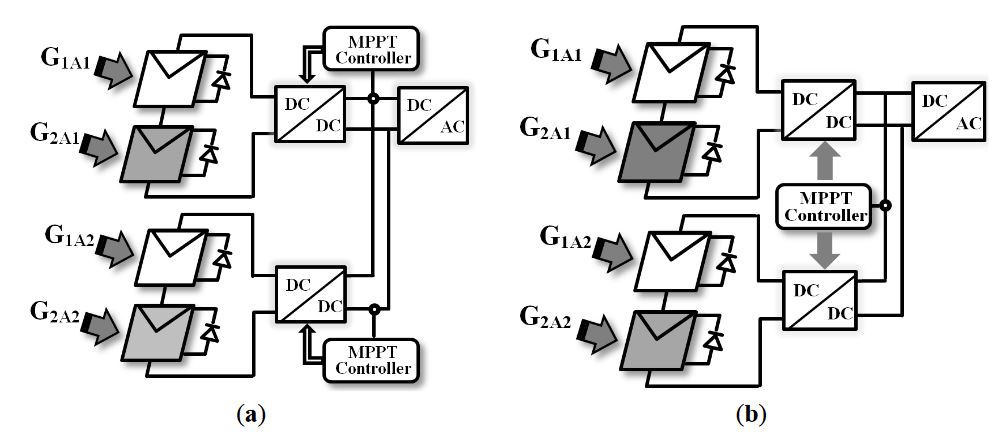ABSTRACT
As of today, the considerable influence of select environmental variables, especially irradiance intensity, must still be accounted for whenever discussing the performance of a solar system. Therefore, an extensive, dependable modeling method is required in investigating the most suit able Maximum Power Point Tracking (MPPT) method under different conditions.
Following these requirements, MATLAB-programmed modeling and simulation of photovoltaic systems is presented here, by focusing on the effects of partial shading on the output of the photovoltaic (PV) systems. End results prove the reliability of the proposed model in replicating the aforementioned output characteristics in the prescribed setting. The proposed model is chosen because it can, conveniently, simulate the behavior of different ranges of PV systems from a single PV module through the multidimensional PV structure.
MODELING OF PHOTOVOLTAIC SYSTEM PARAMETERS

Figure 1. Equivalent circuit of a photovoltaic array
The single-diode circuitry for a photovoltaic cell is represented in Figure 1. Normally, the output of photovoltaic systems corresponds directly to solar irradiance and temperature, so obtaining the maximum power point should involve the most recent values of these factors.
CHARACTERISTICS OF THE PV SYSTEM UNDER PARTIAL SHADING

Figure 3. PV system under partially shaded conditions caused by passing cloud
In any outdoor environment, the whole or some parts of the PV system might be shaded by trees, passing clouds, high building, etc., which result in non-uniform insolation conditions as in Figure 3. During partial shading, a fraction of the PV cells which receive uniform irradiance still operate at the optimum efficiency. Since current flow through every cell in a series configuration is naturally constant, the shaded cells need to operate with a reverse bias voltage to provide the same current as the illumined cells.

Figure 7. Series connected configuration of modules in an array
In experiments, the solar arrays inclusive of several PV modules are used to generate a higher level of electrical output power. The output power of the array may lead to a complex form when facing partial shading conditions. The mathematical analysis on the output characteristics of the PV array consisting of several modules in an array is presented in this section. Figure 7 shows K series connected modules in an array.
NUMERICAL EXAMPLES

Figure 11. Multidimensional PV system (a) Controlled by multiple controllers; (b) Controlled by centralized controllers
Figure 11a shows a multidimensional PV system in which each PV array is controlled by its individual DC/DC converter. Despite the disadvantageous need for numerous sensors and transducers, this system can minimize the effects of partial shading while meeting the load demand.
One solution is considering a centralized controller which would supply the required alternating patterns of each converter just as well. Therefore, the configuration shown in Figure 11b is proposed as a compromise, to increase the output power of the PV system and reduce the number of sensors needed at the same time.

Figure 13. Appeared regions at output of partial shaded multidimensional PV system
The graph presented in Figure 13 shows four distinct regions marked by differences in the output’s characteristics created by each individual array. It also proves that MPP occurs inside the region in which the contribution of individual array to generate the power is maximized.
CONCLUSIONS
As discussed in the analytical modeling of photovoltaic systems, the model should consider all the parameters of the photovoltaic system under normal conditions and also partial shading. The latter condition was simulated in a step by step analysis, using a range of irradiance levels for G1 and G2, and a model encompassing PV modules connected in series with individual bypass diodes. The study then proceeded by modeling the multidimensional structure of PV systems which is known as a cost-effective configuration for PV arrays. This system significantly reduces the number of sensors and transducers utilized in control system.
The cost effective aspect of this configuration can be even more apparent when the large scale PV farm is the case. The final results show how the output characteristics of PV system are the combination of output behavior of each PV array involved in the whole system. The study shows even the mathematical modeling of large n-dimensional PV system in which the central controller tracks the MPP for all the PV arrays, can be achieved by only analyzing the characteristic of the PV arrays inside the system.
Source: University of Malaya
Authors: Mohammadmehdi Seyedmahmoudian | Saad Mekhilef | Rasoul Rahmani | Rubiyah Yusof | Ehsan Taslimi Renani
>> 200+ Matlab Projects for Control System for Final Year Students